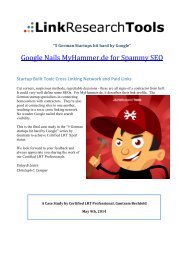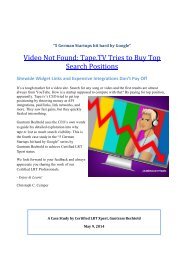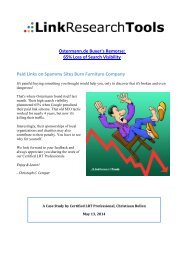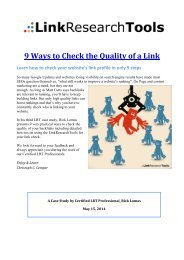The Ultimate Guide to Link Removal
You also want an ePaper? Increase the reach of your titles
YUMPU automatically turns print PDFs into web optimized ePapers that Google loves.
<strong>The</strong> <strong>Ultimate</strong> <strong>Guide</strong> <strong>to</strong> <strong>Link</strong> <strong>Removal</strong><br />
How <strong>to</strong> Find, Identify, and Remove Dangerous <strong>Link</strong>s<br />
Once upon a time, any link was a good link. Now many of those links are suspicious and <strong>to</strong>xic,<br />
dangerous <strong>to</strong> your site's long term search<br />
visibility. Simply keeping up with search<br />
engine changes and link profiles can be a<br />
full time job.<br />
As search engines get smarter, link risk<br />
management becomes more and more<br />
essential. But how <strong>to</strong> do it? In this highly<br />
detailed guide, Bar<strong>to</strong>sz takes us step-by-step<br />
through the link removal process. He shares<br />
many of his secrets, including a deliciously<br />
sneaky way <strong>to</strong> find hidden contact<br />
information for spammy webmasters.<br />
We look forward <strong>to</strong> your feedback and<br />
always appreciate you sharing the work of<br />
our Certified LRT Professionals.<br />
Enjoy & Learn<br />
Chris<strong>to</strong>ph C. Cemper<br />
A Case Study by Certified LRT Xpert, Bar<strong>to</strong>sz Góralewicz<br />
May 16th, 2014
Table of contents<br />
Introduction ................................................................................................................................................................ 2<br />
Identifying the links that have <strong>to</strong> be removed ............................................................................................... 2<br />
<strong>Link</strong> De<strong>to</strong>x ............................................................................................................................................................... 3<br />
TOX1 .......................................................................................................................................................................... 6<br />
TOX2 ....................................................................................................................................................................... 13<br />
TOX3 ....................................................................................................................................................................... 15<br />
SUSP rules ............................................................................................................................................................. 16<br />
What else <strong>to</strong> look for while preparing the links for link removal ................................................... 17<br />
<strong>Link</strong> <strong>Removal</strong> – the ultimate tu<strong>to</strong>rial ............................................................................................................. 18<br />
Matching the <strong>to</strong>ols <strong>to</strong> your needs ................................................................................................................ 18<br />
How <strong>to</strong> start contacting webmasters ......................................................................................................... 18<br />
How <strong>to</strong> remove those links ............................................................................................................................ 19<br />
What should I write in a link removal email? ......................................................................................... 21<br />
Summary ............................................................................................................................................................... 22<br />
Outreach example.............................................................................................................................................. 23<br />
Hidden WHOIS hacking by Bar<strong>to</strong>sz Góralewicz® ..................................................................................... 25<br />
Mail-Baiting by Bar<strong>to</strong>sz Góralewicz ........................................................................................................... 26<br />
Summary ............................................................................................................................................................... 27<br />
Author Bio: ............................................................................................................................................................... 29<br />
Page 1
Introduction<br />
Google is getting better and better at spotting bad links. <strong>Link</strong> audits are no longer an “option,”<br />
they’re a necessity. Nowadays, each site has <strong>to</strong> moni<strong>to</strong>r their backlinks <strong>to</strong> lower their link risk.<br />
But how do we know if the link should be removed? <strong>Link</strong> Research Tools and <strong>Link</strong> De<strong>to</strong>x helps<br />
us identify all the bad links that have <strong>to</strong> be no-followed, disavowed or removed.<br />
<strong>Link</strong> removal is a “must” with a manual penalty. But keeping your link profile clean is getting so<br />
important that I often recommend link removal <strong>to</strong> my cus<strong>to</strong>mers even if they were not (yet)<br />
affected by the Penguin algorithm or a manual penalty. I also have many large companies that<br />
want <strong>to</strong> remove bad/spammy links, not because they fear a penalty, but because they don’t<br />
want <strong>to</strong> be affiliated with any SPAM actions. <strong>The</strong>y do it as a part of their reputation<br />
management.<br />
Identifying the links that have <strong>to</strong> be removed<br />
This could be a whole separate article, but I will only cover some essential principles. <strong>The</strong>re is<br />
no doubt that we want <strong>to</strong> remove links from:<br />
<br />
<br />
<br />
<br />
<br />
<br />
<br />
<br />
<br />
<br />
<br />
<br />
<br />
<br />
<strong>Link</strong> networks<br />
Article submissions<br />
Direc<strong>to</strong>ry submissions<br />
Duplicate content links (e.g. guest blog duplicated over 100s of domains)<br />
Spammy bookmarking sites<br />
Forum profiles (if done for backlinks)<br />
Malware/hacked sites<br />
Gambling/Adult sites (if your site is not in the same niche)<br />
Comment links with over-optimized anchor text (e.g. Cheap Flights instead of John Doe)<br />
Blog roll links<br />
Footer links<br />
Sitewide links (in most cases)<br />
Scraper sites<br />
Any au<strong>to</strong>-generated links (xRumer forum posts, etc.)<br />
Of course, use common sense before removing any links. <strong>The</strong> links above should be removed in<br />
99.99% of situations.<br />
Page 2
<strong>Link</strong> De<strong>to</strong>x<br />
In most cases, it is really difficult <strong>to</strong> see some backlink problems just by looking at the link list.<br />
Fortunately, <strong>Link</strong> De<strong>to</strong>x can do most of the heavy lifting for us and help us with the link audit.<br />
OK, I got the report from <strong>Link</strong> De<strong>to</strong>x…which links should I remove now?<br />
As Matt Cutts would say, “This is a really interesting question.” Let me explain it step by step.<br />
Go <strong>to</strong> the <strong>Link</strong> Research Tools <strong>to</strong>olbox and create a <strong>Link</strong> De<strong>to</strong>x project.<br />
Now enter the domain you want <strong>to</strong> analyze.<br />
Page 3
It is important <strong>to</strong> link your domain with Google Webmaster Tools (WMT), as this allows <strong>Link</strong><br />
Research Tools <strong>to</strong> au<strong>to</strong>matically download WMT links. You can find out more about that here:<br />
https://www.linkresearch<strong>to</strong>ols.com/<strong>to</strong>olkit/webmaster_<strong>to</strong>ols.php?step=1<br />
After you enter the domain address, you need <strong>to</strong> upload an up-<strong>to</strong>-date disavow file (if you have<br />
any uploaded in WMT). This way, your <strong>Link</strong> De<strong>to</strong>x score is going <strong>to</strong> be 100% valid.<br />
Page 4
After your disavow file is submitted, just click “De<strong>to</strong>x my site.”<br />
You can see your project in the “Reports” tab in <strong>Link</strong> Research Tools.<br />
After the progress changes <strong>to</strong> “Done,” you can start classifying the keywords.<br />
Page 5
After your keywords are classified and report reprocessed, you can start looking for links that<br />
have <strong>to</strong> be removed.<br />
Sorting the links<br />
After you start the link audit, it is really important <strong>to</strong> keep it as organized as possible.<br />
Fortunately, <strong>Link</strong> De<strong>to</strong>x makes it quite easy. You have a few options <strong>to</strong> choose from. For link<br />
removal, the best one is the tag field.<br />
How <strong>to</strong> spot bad links even quicker with <strong>Link</strong> De<strong>to</strong>x?<br />
After using <strong>Link</strong> Research Tools for so many audits, I found some tricks <strong>to</strong> speed up finding<br />
really bad links that should be removed.<br />
Prioritizing link removal<br />
First – I always recommend removing links from Google-banned domains.<br />
TOX1<br />
Google-banned domains = TOX1<br />
Page 6
Of course, not all of the links have <strong>to</strong> be removed, nor are all of them not-indexed in Google<br />
because of banning.<br />
After you list ONLY TOX1 links, review them in the De<strong>to</strong>x Screener Tool.<br />
Now go <strong>to</strong> De<strong>to</strong>x Screener where you need <strong>to</strong> mark the links that have <strong>to</strong> be removed.<br />
Page 7
How do you know if this link should be removed? We need <strong>to</strong> go the extra mile here and<br />
manually check if it’s okay or not. In my opinion, here is where most people fail. <strong>Link</strong> Research<br />
Tools gives you almost all the bad stuff on a plate, but sometimes you actually have <strong>to</strong> check<br />
some stuff by hand.<br />
Let’s look at the link a little bit closer.<br />
http://bloggoodtechniques987.blogspot.co.uk/2006_11_19_archive.html<br />
This is an article hosted on a free blogspot.co.uk blog. It is really difficult <strong>to</strong> say if it is spam or<br />
not by just looking at the website. Believe me, I have seen thousands of high quality sites that<br />
would look spammy at the first glance, and loads of spammy sites with great designs. To sum it<br />
up, don’t judge a site based on its design.<br />
You need <strong>to</strong> check the content. Of course, reading it won’t help us either.<br />
Page 8
Copy selected text and search for it in Google.com.<br />
“Your blog is your means of expressing yourself <strong>to</strong> the world. It is a very powerful way of<br />
branding yourself and a very effective means of building a relationship.”<br />
Page 9
As you can see, it is an over-distributed article, probably with some article submission<br />
software. But what is the most important thing on the screenshot above? Look closely…<br />
November 14 th 2006 – do you remember the date on our blogspot blog? I bet you don’t .<br />
Page 10
This is 100% proof that our blogspot.com site is definitely not a keeper.<br />
It is really important that the technique shown above isn’t the only one you use for everything.<br />
Every niche is different, and you need <strong>to</strong> implement different strategies for each of your<br />
cus<strong>to</strong>mers. Sometimes it may be quite easy (like spammy blog comments or direc<strong>to</strong>ries), and<br />
sometimes it may take a lot of time (content scrapers, etc.).<br />
Now all you have <strong>to</strong> do is tag the link and mark it for removal.<br />
Page 11
Once it is done, go <strong>to</strong> <strong>Link</strong> De<strong>to</strong>x <strong>to</strong> easily find and export only the links you want <strong>to</strong> remove.<br />
Filter the data and export in<strong>to</strong> CSV or XLS.<br />
Takeaway:<br />
This is where 95% of people doing link audits fail. Going that extra mile is extremely crucial <strong>to</strong><br />
doing it right. I have seen hundreds of disavow files with valuable links disavowed because<br />
some non-professionals did them.<br />
Page 12
What’s next?<br />
After you are finished with TOX1, I would proceed <strong>to</strong> sites affected by Virus and Malware<br />
(TOX2) in a similar way.<br />
TOX2<br />
In this case, all you have <strong>to</strong> do is check if the site is really affected with some kind of virus. <strong>Link</strong><br />
Research Tools is precise at showing infected sites. If you find a high quality site infected with a<br />
virus, contact the webmaster <strong>to</strong> help them fix the site, not remove the link.<br />
Takeaway:<br />
Here are some <strong>to</strong>ols <strong>to</strong> help you can your site for malware:<br />
http://app.webinspec<strong>to</strong>r.com/<br />
From what I understand, it actually crawls the URL/Website and checks it online.<br />
Page 13
https://www.virus<strong>to</strong>tal.com/<br />
Checks for the site’s presence on many different black lists.<br />
Page 14
http://www.urlvoid.com/<br />
Similar <strong>to</strong> VirusTotal.com – it checks the site’s presence on 27 different blacklists.<br />
After you finish the TOX2 links, you can move forward <strong>to</strong> the next step.<br />
TOX3<br />
This is actually one of the trickiest issues. TOX3 means that “<strong>The</strong> <strong>Link</strong> De<strong>to</strong>x Genesis<br />
algorithm classified this link as very unnatural. We recommend removing this link or<br />
disavowing it using the Google disavow <strong>to</strong>ol.”<br />
To explain it simply – in my understanding – many penalized domains have links from websites<br />
marked as TOX3.<br />
Page 15
TOX3 is a powerful <strong>Link</strong> De<strong>to</strong>x Rule, but it has <strong>to</strong> be interpreted wisely. It can precisely show us<br />
all the bad bookmarking sites, spammy direc<strong>to</strong>ries, and so on. BUT it can sometimes return<br />
false negatives. You need <strong>to</strong> check all TOX3 links with the <strong>Link</strong> De<strong>to</strong>x Screener!<br />
SUSP rules<br />
This is where things get REALLY interesting. TOX1, TOX2, TOX3 are (in my opinion) the<br />
“simplest” algorithms in <strong>Link</strong> De<strong>to</strong>x. “SUSP rules,” as I call them, are where we get in<strong>to</strong> the real<br />
game.<br />
I will not go in<strong>to</strong> detail of how you should use them step by step, as it could take few separate<br />
articles, but I can quickly cover what is most interesting and efficient.<br />
<strong>The</strong> list of SUSP and TOX rules can be found here - http://www.linkde<strong>to</strong>x.com/faq/.<br />
I have had many conversations with fellow CLRTPs about their workflow, and there is no rule<br />
on what they look at. Everyone has their own path <strong>to</strong> success. Here is just a quick little glance at<br />
how I do it:<br />
I start with SUSP6, SUSP7, SUSP8 and SUSP9. Those are all the rules for link networks. I<br />
personally think they can cause your site the most harm, and they are extremely easy <strong>to</strong> detect<br />
if done poorly.<br />
What I like the most about this functionality is that I am able <strong>to</strong> see other domains linking <strong>to</strong><br />
the site I am working with, and which have same IPs, DNS, etc. You can do this by clicking “+”<br />
next <strong>to</strong> the URL.<br />
After that, you can see all the domains “connected” <strong>to</strong> this URL.<br />
Page 16
Of course, it is important <strong>to</strong> double-check all the domains. In this case, what I think can be false<br />
positive possibilities are as follows:<br />
<br />
<br />
<br />
<br />
<br />
Free hosting<br />
SEO agency with different blogs (for example blogs by their employees) – all hosted on<br />
the same server<br />
Free/Paid web 2.0 properties (e.g. Blogspot, Weebly etc.)<br />
Shared hosting (if you have thousands of referring domains, there is a high chance that<br />
some of them will be hosted in the same shared hosting)<br />
Many other scenarios<br />
What else <strong>to</strong> look for while preparing the links for link removal<br />
Apart from that, it is worth it <strong>to</strong> look at:<br />
<br />
<br />
<br />
Site vs. PageRank<br />
o Website with 2,000,000 indexed pages and PageRank 0 is most likely SPAM.<br />
Age vs. PageRank<br />
o Site that is online for 10 years and still has PageRank N/A or 0 also should raise a<br />
flag.<br />
Amount of referring domains vs. <strong>to</strong>pdomain CEMPER Trust<br />
o 1,000 referring domains and CEMPER Trust 1 means unnatural linking <strong>to</strong> the<br />
site.<br />
Page 17
Sitewide links (in 9 out of 10 cases – bad stuff)<br />
Footer links<br />
Any link patterns<br />
Most of that can be easily done with <strong>Link</strong> De<strong>to</strong>x. For those of you who feel a little insecure in<br />
this field, you can get <strong>to</strong> know <strong>Link</strong> Research Tools for free by getting certified as an LRT<br />
associate here - http://www.linkresearch<strong>to</strong>ols.com/training/.<br />
OK, now that we’ve got the list, we can start the actual link removal process.<br />
<strong>Link</strong> <strong>Removal</strong> – the ultimate tu<strong>to</strong>rial<br />
Matching the <strong>to</strong>ols <strong>to</strong> your needs<br />
<strong>The</strong>re are two ways <strong>to</strong> approach the link removal. It all depends on 2 things:<br />
A. Volume of links<br />
B. Single website vs. <strong>Removal</strong> services (agency, etc.).<br />
If you work on a single website and you have just a few hundred links <strong>to</strong> remove, then you can<br />
go with the manual approach <strong>to</strong> contacting the webmasters.<br />
For agencies that work on many websites and have many links <strong>to</strong> remove, I highly recommend<br />
au<strong>to</strong>mating the process <strong>to</strong> some point. You can do it with www.pitchbox.com which is the best<br />
option for scaling outreach, in my experience.<br />
How <strong>to</strong> start contacting webmasters<br />
For some sites, manual contact is the only option. Those are usually the sites with no email on<br />
their website and hidden WHOIS data. In that case, our only option is <strong>to</strong> contact the<br />
webmasters using the contact form on the website.<br />
Now let’s come back <strong>to</strong> our <strong>Link</strong> De<strong>to</strong>x.<br />
I’ve picked the first domain with the TOX1 rule.<br />
http://textlinkinfo.com/archive-2009-09.html<br />
Page 18
As you can clearly see, it is some kind of au<strong>to</strong> scraper. It scrapes e.g. Twitter and publishes the<br />
content as posts.<br />
How <strong>to</strong> remove those links<br />
This is an interesting example, as the blog is completely de-indexed from Google, and we can<br />
clearly see why. <strong>The</strong>re is no robots.txt file and it clearly looks like the Google Ban.<br />
Now we need <strong>to</strong> contact the site’s owner and ask him <strong>to</strong> remove the link <strong>to</strong> our site.<br />
Fortunately, we have the contact form on this website.<br />
Page 19
But quite often, messages sent by using such contact forms are not received/moni<strong>to</strong>red by<br />
anyone.<br />
If you don’t get any replies after a few days, it is worth using the contact mail from WHOIS.<br />
You can do that by checking the WHOIS data here:<br />
http://www.whois.com/whois/<br />
Page 20
If you are not familiar with how WHOIS works, read more about WHOIS.<br />
What should I write in a link removal email?<br />
This is one of the trickiest moments.<br />
If you want your email <strong>to</strong> be successful, you need 3 things:<br />
<br />
<br />
<br />
Perseverance<br />
Creativity<br />
Making it easy for webmasters<br />
Now, let’s walk through these fac<strong>to</strong>rs step by step.<br />
1. Perseverance<br />
From what I read, sending a follow-up email can increase our chances up <strong>to</strong> 75%.<br />
This makes it crucial <strong>to</strong> keep track of our actions and <strong>to</strong> not give up quickly.<br />
Takeaways:<br />
If you are using Pitchbox, set up a 2 nd and 3 rd outreach. Keep the message different<br />
every time!<br />
2. Creativity<br />
Many sites you will be contacting get hundreds of link removal emails weekly. If you<br />
want <strong>to</strong> have awesome results, you need <strong>to</strong> be really creative. Basically, you need <strong>to</strong><br />
be more creative than those other hundreds.<br />
Takeaways:<br />
Page 21
All the link removal templates you will find are super official. Don’t use them. Write<br />
something casual and simple. With the less official sites we work on, we even<br />
sometimes leave some typos. It makes our outreach look less “au<strong>to</strong>mated.” In my<br />
experience, this often helps with “no answer” webmasters.<br />
When contacting webmasters, use your real name and real social media accounts in<br />
your footer. Also, it is good <strong>to</strong> contact people through Facebook, Twitter or Google+.<br />
This makes it more personal, and people are more likely <strong>to</strong> remove the links.<br />
3. Making it easy for webmasters<br />
Summary<br />
<br />
<br />
<br />
This one is pretty obvious, but you would be surprised how many people get it<br />
wrong.<br />
It is extremely important <strong>to</strong> make link removal as easy as possible for webmasters<br />
receiving your email. Most of them will be frustrated with your request. Making<br />
them look for your link obviously doesn’t increase your success rate.<br />
Make it simple for webmasters <strong>to</strong> remove your links by giving them the URL of their<br />
page with the link <strong>to</strong> your site. Also, be extra nice in the email, even if the site linking<br />
<strong>to</strong> you is <strong>to</strong>tal SPAM. You want something FROM them for free (in the best-case<br />
scenario). Don’t threaten or insult them.<br />
Takeaways:<br />
1. If you think the site is great, but the link was listed as an example in a Google<br />
Unnatural <strong>Link</strong>s message and you have <strong>to</strong> remove it <strong>to</strong> lift the penalty, kindly<br />
ask for its removal. Even if site is 100% scraped from Wikipedia, I would just<br />
stick <strong>to</strong> being nice. <br />
2. In your link removal outreach, be as detailed as possible. Not only show them<br />
your links, but also show them where exactly they are located on their site. If<br />
possible, include screenshots, videos, etc.<br />
3. If necessary, offer technical help in removing the link for free. Some people<br />
just don’t know how <strong>to</strong> do it.<br />
Whatever you do, please remember that you are asking webmasters for a “favor.”<br />
If you are talking <strong>to</strong> the owners of SPAM sites, or sites that spammed you, be super<br />
polite and calm. I have some cus<strong>to</strong>mers being blackmailed by the owners of thousands<br />
of spam direc<strong>to</strong>ries. Removing the links from such a huge network is usually priced at<br />
around $2,000 <strong>to</strong> $2,500—even if you didn’t want those links in the first place!<br />
If you or the agency working for you spammed somebody’s website (e.g. with spammy<br />
comments), this is another s<strong>to</strong>ry.<br />
o Admit that you or your decisions caused the spamming of his site.<br />
o Apologize for your actions, and don’t blame them on others.<br />
o Make sure that you don’t create such links any more (the webmaster WILL check<br />
that, <strong>to</strong>o).<br />
Page 22
o <strong>The</strong> guy reading your email will probably not be your biggest fan, as he probably<br />
spends a good few hours per week cleaning his website from SPAM.<br />
o Be honest and admit that you are cleaning up your act.<br />
Outreach example<br />
I know I covered the “how <strong>to</strong> write a good outreach part” in detail already, but <strong>to</strong> make it super<br />
easy for you, I will give you a free template. Please keep in mind that it is always better <strong>to</strong><br />
create your own template. Doing so enables you <strong>to</strong> be 100% sure it is unique and that the<br />
webmaster you are contacting didn’t get the same email an hour ago.<br />
Keep in mind that this is just an example and not a real scenario.<br />
Hello Matt,<br />
EXAMPLE -generic<br />
My name is Bar<strong>to</strong>sz Goralewicz and I am the owner of www.goralewicz.co. I’m working<br />
<strong>to</strong>wards cleaning the links that have been created on your website:<br />
http://www.mattcutts.com/blog/guest-blogging/<br />
This is the comment link, which can easily be found by going <strong>to</strong> your subpage<br />
http://www.mattcutts.com/blog/guest-blogging/ and pressing CTRL/CMD + F and searching<br />
for “Bar<strong>to</strong>sz Goralewicz”.<br />
I am trying <strong>to</strong> get it removed as I’ve created <strong>to</strong>o many comment links <strong>to</strong> my website and I want<br />
<strong>to</strong> clean up my link profile.<br />
I hope you will be able <strong>to</strong> help me out. If you encounter any problems, I am happy <strong>to</strong> assist you<br />
with any technical aspects. You can reach me at bar<strong>to</strong>sz@goralewicz.co or call me at +48<br />
12345789.<br />
Kind Regards<br />
Bar<strong>to</strong>sz Goralewicz<br />
Page 23
Connect with me:<br />
e-mail: bar<strong>to</strong>sz@goralewicz.co<br />
phone: +48 12345789.<br />
website: http://goralewicz.co<br />
FB: http://facebook.com/goralewicz<br />
Twitter: http://twitter.com/bart_goralewicz<br />
Example – creative<br />
Hello Webmaster,<br />
You’ve got a link on your site (http://www.mattcutts.com) linking <strong>to</strong> http://goralewicz.co.<br />
http://www.mattcutts.com/blog/guest-blogging/<br />
It is a comment link which can easily be found by going <strong>to</strong> your subpage<br />
http://www.mattcutts.com/blog/guest-blogging/ and pressing CTRL/CMD + F and searching<br />
for “Bar<strong>to</strong>sz Goralewicz”.<br />
I would greatly appreciate you removing the link, as it makes some people’s lives very<br />
complicated…<br />
Page 24
Also – I want <strong>to</strong> assure you that your website is of highest quality and I want <strong>to</strong> remove the link<br />
only due <strong>to</strong> my SEO misbehaves in the past.<br />
Thanks<br />
Bar<strong>to</strong>sz<br />
This is just a quick example. It is far from being a masterpiece, but you get the general idea. You<br />
can read about one more similar idea (even better, <strong>to</strong> be honest) here -<br />
http://searchengineland.com/webmasters-getting-creative-link-removal-requests-works-<br />
187884<br />
Takeaways:<br />
I wouldn’t contact <strong>to</strong>o many websites using your real email. Leave it only for the websites<br />
where you know that somebody will not SPAM you later. You would be surprised how much<br />
we’re spammed at the email addresses we are using for link removal outreach. One of the best<br />
practices is <strong>to</strong> create a separate email within your domain. Of course, don’t name it<br />
linkremoval@mydomain.com. I usually go with marketing@mydomain.com or simply the name<br />
of the person doing webmaster outreach.<br />
Hidden WHOIS hacking by Bar<strong>to</strong>sz Góralewicz®<br />
Now, remember that you read it here first. This is my own way of getting webmasters with<br />
hidden WHOIS domains <strong>to</strong> remove your links.<br />
All we need <strong>to</strong> do is get their real email. You would be shocked at the expected success rate.<br />
Guys with hidden WHOIS domains will be really surprised <strong>to</strong> get a link removal request from<br />
you – mostly because they have no idea how you got their email. This is how it is done:<br />
What do we need?<br />
<br />
<br />
<br />
<br />
Fake domain<br />
Fake email on that domain<br />
Some creativity<br />
Patience<br />
Page 25
Mail-Baiting by Bar<strong>to</strong>sz Góralewicz<br />
Let me walk you step by step through the mail–baiting process:<br />
1. Buy a domain with a fake name connected <strong>to</strong> domain buying.<br />
2. Install WordPress with a “coming soon” plugin. For example:<br />
https://wordpress.org/plugins/ultimate-coming-soon-page/screenshots/<br />
3. Make it look good and real<br />
4. Create an email within the domain<br />
5. Use it <strong>to</strong> contact the webmaster about buying his domain name<br />
6. Get his reply (and his email)<br />
7. Wait 2 – 3 weeks<br />
8. Contact the webmaster about link removal<br />
Real life example<br />
Enough with the theory, let’s start with some real life examples.<br />
1. I went <strong>to</strong> NameCheap.com, and I bought the domain name -<br />
http://wewantyour.domains/<br />
2. I’ve installed WordPress on one of my hosting servers and redirected the DNS. After a<br />
DNS propagation, I’ve installed the “coming soon” plugin.<br />
3. I made it look professional enough <strong>to</strong> be believable.<br />
Page 26
4. Created the email account - hunter@wewantyour.domains<br />
Steps 5 – 8 are pretty much self-explana<strong>to</strong>ry. Of course, feel free <strong>to</strong> modify this method in any<br />
way you like. <strong>The</strong> more creative you get, the better it works.<br />
Summary<br />
<strong>The</strong>re aren’t many ways <strong>to</strong> remove bad links. It all comes down <strong>to</strong> giving the webmaster some<br />
motivation <strong>to</strong> actually go the extra mile and remove the link that we’ve pointed.<br />
While doing all that, we need <strong>to</strong> be aware that we’ve got “a little” power, <strong>to</strong>o. Many webmasters<br />
are aware that disavowing their domain is not a very good ranking fac<strong>to</strong>r for Google. <strong>The</strong>y will<br />
remove the link and notify you about that <strong>to</strong> keep their domain “safe.” Unfortunately, this is not<br />
the case for medium/low quality sites.<br />
You also need <strong>to</strong> remember that the removal itself is only half of the battle. Picking the right<br />
links is one of the most crucial and most time-consuming parts. This is also where most SEOs<br />
fail.<br />
Page 27
Some people say that link removing is the new link building nowadays. I agree with that <strong>to</strong><br />
some point. <strong>The</strong>re are actually many more similarities. With link building, the #1 success fac<strong>to</strong>r<br />
is creativity. This seems <strong>to</strong> be exactly the same with link removal.<br />
This excellent guide was written by Bar<strong>to</strong>sz Góralewicz, CEO at Elephate, and proud user of<br />
<strong>Link</strong> Research Tools and <strong>Link</strong> De<strong>to</strong>x.<br />
A word from Chris<strong>to</strong>ph C. Cemper<br />
Shared advice and guidance like Bar<strong>to</strong>sz demonstrated here is why we build and cultivate certified<br />
professionals. As iron sharpens iron, our professionals sharpen each other's skills, making us better at<br />
what we do.<br />
<strong>The</strong>refore, I’m very happy <strong>to</strong> certify Bar<strong>to</strong>sz Góralewicz as the latest Certified LRT Xpert by<br />
approving and publishing his research on our site.<br />
Our goal is <strong>to</strong> provide our user community and clients with quality service and knowledge. Our<br />
Certified LRT Professionals are key <strong>to</strong> achieving this goal.<br />
I look forward <strong>to</strong> his future work, and personally recommend working with Bar<strong>to</strong>sz Góralewicz<br />
whenever you get the opportunity!<br />
Page 28
Author Bio:<br />
Bar<strong>to</strong>sz Góralewicz<br />
CEO at Elephate (http://goralewicz.co)<br />
Bar<strong>to</strong>sz Góralewicz specializes in link audits. He does<br />
consulting mostly for corporate cus<strong>to</strong>mers and large<br />
sites. You can find some of his case studies or<br />
interesting posts at http://goralewicz.co.<br />
<strong>Link</strong>edin: http://pl.linkedin.com/pub/bar<strong>to</strong>szg%C3%B3ralewicz/8a/827/283?trk=cws-ppw-member-0-0<br />
Google+: https://plus.google.com/+Bar<strong>to</strong>szGoralewicz?prsrc=5<br />
Twitter: Twitter.com/bart_goralewicz<br />
Facebook: FB.com/goralewicz<br />
Page 29








